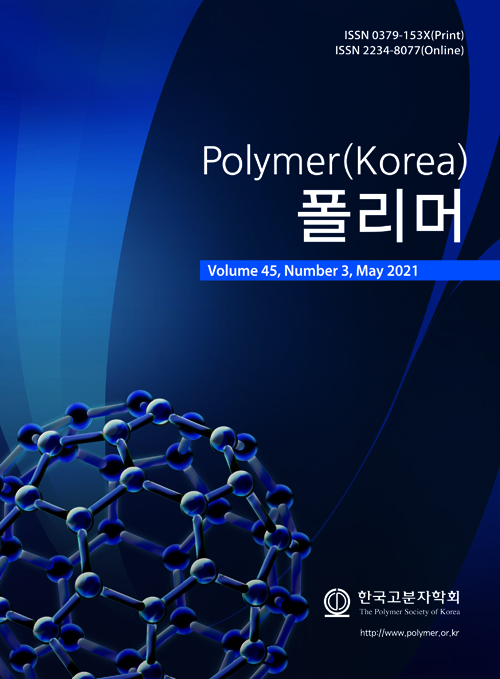- Polymerization of Vinyl Acetate Initiated by Hydrosilane in the Presence of Platinum Complex
Ming Yuan, Wenxian Zhu, Jiaxing Lv, Panpan Zhang*, and Huadong Tang†

Institute of Industrial Catalysis, College of Chemical Engineering, Zhejiang University of Technology, Hangzhou, Zhejiang 310014, China
*State Key Laboratory of Modern Optical Instrumentation, Zhejiang University, Hangzhou, Zhejiang 310027, China- 백금계 촉매와 Hydrosilane 개시제를 이용한 아세트산 비닐 합성
Reproduction, stored in a retrieval system, or transmitted in any form of any part of this publication is permitted only by written permission from the Polymer Society of Korea.
In this work, a series of hydrosilanes including phenylsilane, diphenylsilane, triethylsilane (TES), and tris(trimethylsilyl)silane combined with catalytical amount of platinum complex such as dichloro(1,5-cyclooctadiene)platinum (COD) and dichloro(dicyclopentadienyl)platinum have been used to initiate the polymerization of vinyl acetate (VAc) at 70-95 ºC. An ultrahigh molecular weight PVAc with number-average molecular weight (Mn) up to 1.17×106 Da and polydispersity index (PDI) of 2.59 has been synthesized using TES as an initiator in the presence of 9.7 ppm of COD. A kinetic study indicates that the polymerization at VAc/TES/COD molar ratio = 3.0×105 : 60 : 1 smoothly reached 81.0% conversion in 28.0 h at 85 ºC, producing PVAc with Mn increasing linearly from 1.41×105 to 6.01×105 Da with the increase of monomer conversion. A mechanistic investigation revealed that COD was firstly reduced by reductive TES, producing Pt nanoparticles and corresponding silane radicals to initiate the polymerization of VAc
Keywords: vinyl acetate, polymerization, hydrosilane, kinetics, mechanism
- Polymer(Korea) 폴리머
- Frequency : Bimonthly(odd)
ISSN 0379-153X(Print)
ISSN 2234-8077(Online)
Abbr. Polym. Korea - 2023 Impact Factor : 0.4
- Indexed in SCIE
 This Article
This Article
-
2021; 45(3): 428-436
Published online May 31, 2021
- 10.7317/pk.2021.45.3.428
- Received on Dec 24, 2020
- Revised on Jan 31, 2021
- Accepted on Feb 22, 2021
 Correspondence to
Correspondence to
- Huadong Tang
-
Institute of Industrial Catalysis, College of Chemical Engineering, Zhejiang University of Technology, Hangzhou, Zhejiang 310014, China
- E-mail: thd@zjut.edu.cn








 Copyright(c) The Polymer Society of Korea. All right reserved.
Copyright(c) The Polymer Society of Korea. All right reserved.